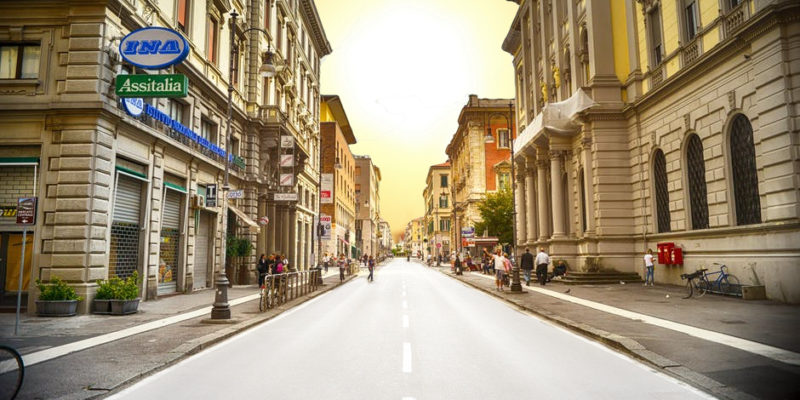During one of the most intense heat waves in Southern California this past week, residents are saying it’s not as bad as it used to be thanks to white pavement, or cool pavement, paving their streets. The experiment was initiated by Los Angeles City councilman Bob Blumenfield, whose constituency resides in the blazing hot southwest San Fernando valley, where temperatures regularly exceed 100 degrees.
What the city did was apply a light gray seal across a blistering half-block stretch of Jordan Avenue and the residents have noticed the cooler temperatures.
Since then, the battleship-gray reflective street surfaces have been added to short blocks in Arleta, Northridge and Hyde Park. Two more are slated to be laid down today in west Los Angeles, among 15 pilot projects across the city.
“It’s cooler,” said Jimenez, whose two daughters translated her Spanish comments outside their Jordon Villa apartment, where they’d set up a portable pool in temperatures that reached a high this week at 104 degrees. “The heat is not so bad.”
The goal of city officials with the white pavement is to reduce the road temperatures and cool the insides of the nearby buildings goal, as well as lessening air pollution and reducing the threat of deaths linked to increasingly hotter heat waves.
If this white pavement experiment is successful, the CoolSeal coating invented by GuardTop LLC could be added to thousands of miles of pending Los Angeles road upgrades.
In a city whose summer temperatures have risen an average 10 degrees in the past century because of increasing sprawls of asphalt, parking lots, roofs and more, Los Angeles city officials say the reflective white pavement roadways may help tone down the concrete baking expected to be get worse and worse.
The gray streets of white pavement could cost between $25,000 and $40,000 per mile and last five to seven years — a cost subject to change pending product and pavement innovation, city and GuardTop officials say.
After a week of blistering heat, a random test on the narrow street north of the Los Angeles River lined with two-story apartment buildings was conducted by three officials. Coincidentally, each arrived separately after the sun apexed on Thursday to measure the effectiveness of the white pavement coating applied May 20.
Patrick Carrigan, an assistant engineer for General Services, pointed a handheld laser thermometer at the gray surface darkened by a month of road grime. It read 138 degrees. He then aimed it at the unpainted crossroad at Hart Street and Jordan Avenue.
“See look at that: 149 degrees, an 11-degree difference,” said Carrigan, on his second visit to Jordan Avenue, which he tested in addition to the three other reflective road sites. “The total average spread is about a 10-degree difference between black-to-gray.”
Blumenfield got similar results, as did a GuardTop executive who dropped by later with another handheld thermometer. Each recorded slightly higher temperatures toward the middle of the gray-painted street stained dark by tires and other road residue.
Two years ago, the councilman had passed a motion to test a new cool pavement that, with more trees and reflective rooftop solar panels, he thought could counter longer and extreme heat waves.
After rigorous testing of the CoolSeal coating for durability and wet skid potential, it was first applied at a Sepulveda Basin parking lot. Summer surface temperatures fell from 20 to 25 degrees.
“It’s great,” said Blumenfield, a former state assemblyman who arrived in a gray suit, blue shirt and fuschia tie. “It’s forward-thinking … it’s a vision for a cooler San Fernando Valley, Canoga Park and Los Angeles.
“It means health … life and death for people. It’s not an academic exercise. If we lowered the temperature in this community, it would mean cost savings for everyone inside and out.”
Among the rows of aging apartments with names like Jordan Villa, Jordan Casa and Jordan Terrace flanked by blooming magnolias or the occasional palm, residents said they already felt the cool.
“Now, it’s a few degrees cooler,” Jimenez said of her apartment. “We like it. If it wasn’t for this street, the heat wave would make my apartment hotter.”
“I feel a slight difference on the street and inside my apartment,” said Priscilla Corleto, 24, walking Gatsby, her small white Shih Tzu. “Without the AC, it seems cooler.
“It’s good. I like it. I think it’s a success.”
Florida could certainly stand to benefit from white pavement roads, as average yearly temperatures here have been increasing too. Innovation is about solving problems and it isn’t limited to technology. Old practices like paving roadways can evolve to lessen the impact of increasing temperatures amongst urban sprawl.

